Island Lake is one of many lakes in the Grouse Ridge area of Nevada County, California. The trails along here are relatively easy, without a lot of elevation change, and you can find an interesting variety of Sierra wildflowers. This is an out-and-back hike, so you can choose how far you want to go. On this visit our trip was about 6 1/2 miles – you can go much further if you choose.
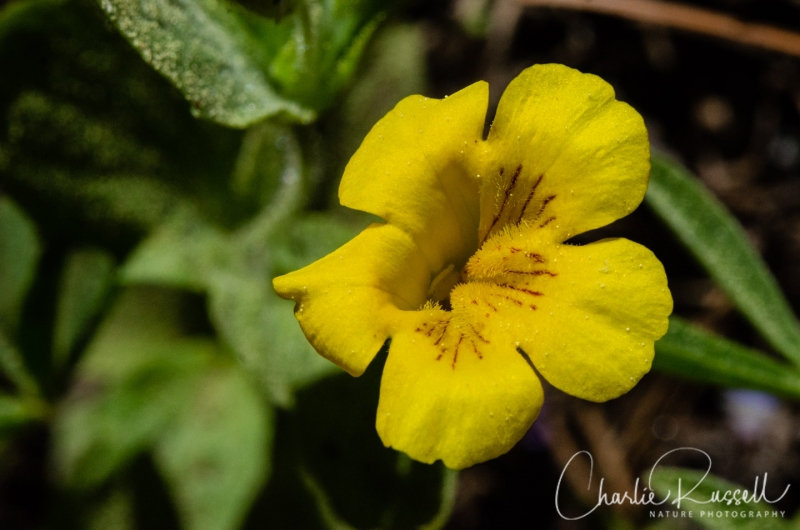
The Hike
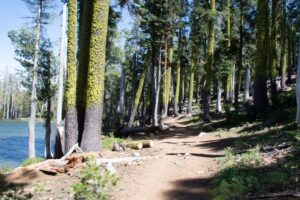
The trailhead starts at the parking area for the Carr Lake campground. There is a trailhead sign, and you will see a gate across the gravel/dirt road heading east. You start off on this road, passing by the campground sites along Carr Lake. Note that before the campground sites the road/trail crosses Lake Creek. It isn’t deep, and on this hike we could cross easily by stepping on rocks, but earlier in the year it might be a bit more difficult to get across dry.
After a few tenths of a mile you come to the dam for Feeley Lake. The trail runs along the edge of this larger lake for about a half mile. You’ll find wildflowers of different sorts scattered along this section. On this trip we were late for most of the fawn lilies, we could see a large number of them gone to seed.
The trail starts to head up onto the hillside with a very moderate climb. It is well maintained and obvious, for the most part. You will pass Delany Lake, which is smaller and starting to turn into a meadow. There are lily pads here, and on the east side we found some remaining shooting stars.
A few tenths of a mile past Delany Lake you will see another lake on the north side of the trail. This doesn’t have a name that I know of, but it feeds into the larger Island Lake just beyond. At this point you want to look for a branch in the trail that heads north, the Crooked Lakes trail. This runs between the smaller lake and Island Lake. The junction, closer to the lake, is where we found a shaded section that still had some fawn lilies in bloom.
The section between the lakes crosses exposed granite, and you will find a different selection of flowers here. Lots of Jewel flowers, Phlox and Pretty face.
The trail wanders alongside of Island Lake. You’ll eventually come to the “peninsula”, a rocky outcropping that projects into the lake. From hear, look to the west (away from the lake). You will see the brush covered slope of Fall Creek Mountain. In Tahoe’s Spectacular Wildflower Trails, Julie Carville talks about climbing up that slope to find a different set of flowers. We didn’t clamber up this time, it is another 600 feet of elevation change with no trail, through the brush, and it didn’t look all that promising this time of year.
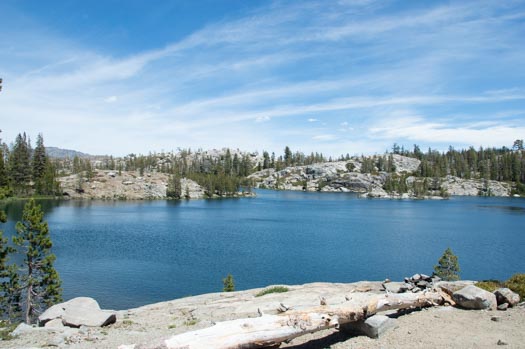
The trail continues through the woods, past several more small lakes and ponds. We came to the crest, where the trail starts to head down towards Penner Lake (a popular area for camping), and decided to turn back. I don’t expect to find a different selection of flowers on the trail past this point. Turning back here made this a 6.6 mile hike, elevation ranging from 6600′ to 6800′.
Here’s the track that we followed:
Island Lake
Profile
Move your mouse along the elevation graph to show the location on the map. The Refresh icon will re-center the map. The Expand icon will expand to full screen.
Directions
Note that to get here you have to drive on some rugged, unpaved forest service roads. We were able to get close to the trailhead using my low clearance Honda CRV, but it was slow going.
From Highway 80 west of Cisco Grove take exit 161 for Highway 20 towards Nevada City. After about 4.2 miles turn north onto Bowman Lake Road. Follow this for 8.4 miles, looking for Forest Service road 17 on your right – you might see signs for Carr Lake. This road is very rugged, take it slow. At 2 miles there is a junction, all directions may be marked as road 17. Turn right. After roughly a half mile you will see some parking spots (just somewhat flat spots off the side of the road). We parked here, because the road that continues up the hill was too rocky for our car. The trailhead is just a few hundred yards past this point, and there is more parking up there (if you can reach it). There is a clear sign marking the Carr Lake trailhead.
If you use Google Maps, search for “Carr Lake Campground”, and use that for directions. Note that you might not have cell phone coverage here, so you want to download the Google Maps information for the area. This worked very well for us.
There are pit toilets in the campground by Carr Lake, a short ways up the trail from the trailhead.
Julie Carvell’s book talks about another site that is very near to to this trailhead, Loney Meadow. We tried (and failed) to find this site, but the directions (and signage) aren’t all that clear, and the road to this area definitely needs a high-clearance vehicle.
Another very interesting hike that we’ve done in the Grouse Ridge area is the trail from Grouse Ridge to Glacier Lake.
Timing is Everything
We visited this area in mid-June. There were lots of flowers blooming, there was no snow on the ground, the creek was easy to cross, and temperatures were in the 70’s. Beautiful! The only drawback was that it was very windy, with gusts over 25 mph at least, which made it difficult to get good pictures (I gave up trying to get a picture of meadow rue on this hike).
I think that this area has a long wildflower season. We did find Fawn lilies, which was exciting, but there were just a few still in bloom. Most of them had already set seed – this hike would have been covered with fawn lily blossoms a month earlier. On the other hand, we found many lupines all along the trail, and they were just starting to bloom, so there should be a good show the end of June into July. Note that in a prior year we hiked to Glacier Lake in this area in mid July.
The Flowers
Here’s a sample of a few of my favorites from this hike.
Mountain pride always stands out. You can recognize this brilliant splash of magenta from a long way away. You’ll often find it on rocky granite outcroppings.
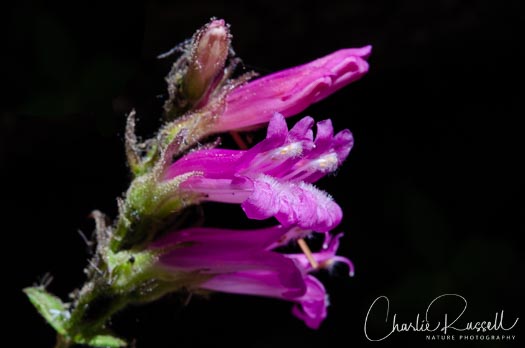
Mountain jewel flower is one of those really odd flowers that don’t look very interesting until you get really close. Here’s a closeup of the very small flower. These are generally found in open rocky areas.
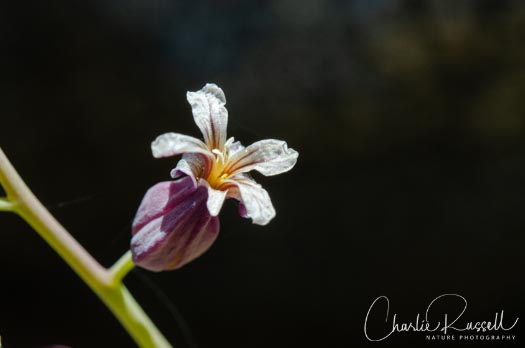
Another flower that is easy to miss is Brewer’s miterwort. The flowers are small and green, on a thin, wispy stem, but when you get close they are very intricate. You will find these in damper areas along the creeks or by the lakes.
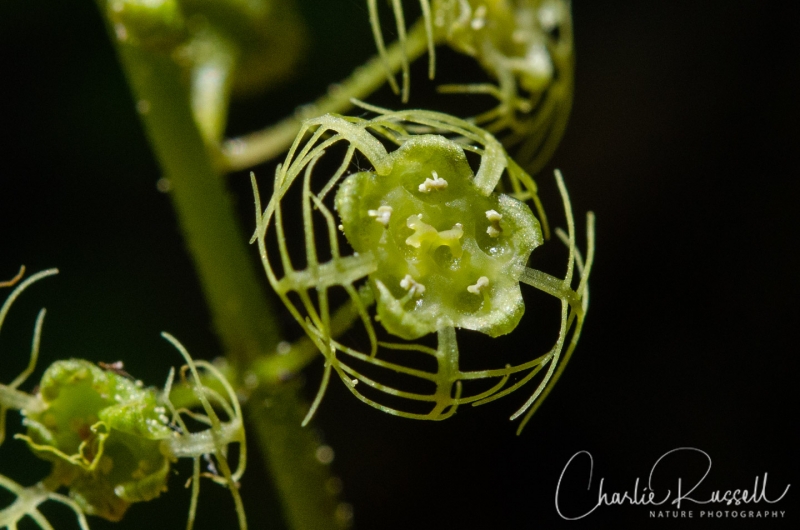
My photo of this next one isn’t too sharp, because it was a very windy day and this small flower was in the shade. Sierra starwort has a CNPS rank of 4.2, which means it has “limited distribution” and is being monitored.
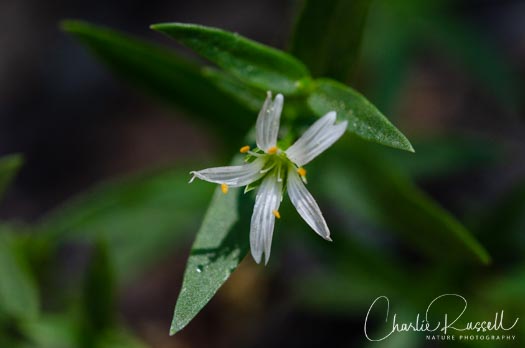
The flower that got us the most excited, however, was the Plain leaf fawn lily. These are small, delicate flowers (just an inch across or less) that start off white and yellow, and then turn light purple when they are pollinated. They are an early-season flower, and we thought we missed them. There were a lot of them on the hike, but they had all gone to seed. Until we found one patch in the shade at Island Lake where there is a trail junction.
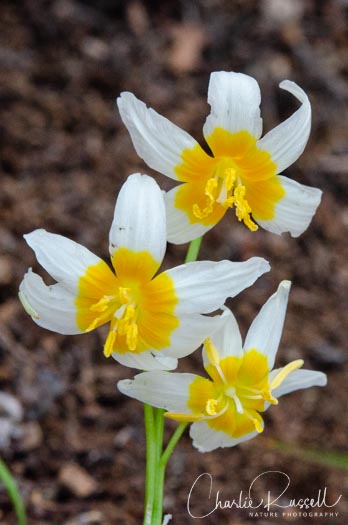
For the best viewing experience, click on the lightbox image below, and you can scroll through larger versions of the photos of many of the plants (and other things) that we found on this hike. All photos are available for purchase in a variety of formats.



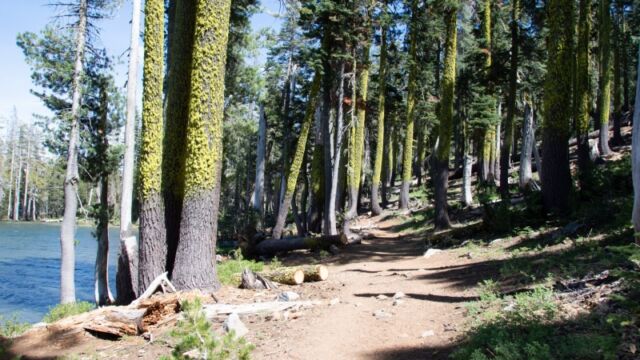
Island Lake Wildflowers
Here’s a listing of the native plants that we found on this visit. The ones listed in color are endemic to California (that is, found only in California).
- Alpine shooting star, Primula tetrandra
- Bitter cherry, Prunus emarginata
- Brewer’s miterwort, Pectiantia breweri
- Brewer’s mountain heath, Phyllodoce breweri
- Crimson columbine, Aquilegia formosa
- Davis knotweed, Aconogonon davisiae
- Dwarf groundsmoke, Gayophytum humile
- Feathery false solomon’s seal, Maianthemum racemosum
- Few flowered blue eyed mary, Collinsia parviflora
- Goosefoot violet, Viola purpurea
- Jacob’s ladder, aka Sky pilot. Polemonium pulcherrimum
- King’s smooth sandwort, Eremogone kingii var. glabrescens
- Macloskey’s violet, Viola macloskeyi
- Mountain butterweed, Senecio integerrimus
- Mountain jewelflower, Streptanthus tortuosus
- Mountain pretty face, Triteleia ixioides ssp. anilina
- Mountain pride, Penstemon newberryi
- Mountain willow, Salix eastwoodiae
- Musk monkeyflower, Erythranthe inodora (formery Mimulus moschatus)
- One seeded pussypaws, Calyptridium monospermum
- Pine forest larkspur, Delphinium gracilentum
- Pine lupine, Lupinus albicaulis
- Pine mat manzanita, Arctostaphylos nevadensis
- Plain leaf fawn lily, Erythronium purpurascens
- Plantainleaf buttercup, Ranunculus alismifolius var. alismifolius
- Sierra starwort, Pseudostellaria sierrae. CNPS rank 4.2
- Sierran woodbeauty, Drymocallis lactea var. lactea
- Spreading phlox, Phlox diffusa
- Sulphur buckwheat, Eriogonum umbellatum
- Velvet stickseed, Hackelia velutina
- Wandering fleabane, Erigeron glacialis var. glacialis
- Water leaf phacelia, Phacelia hydrophylloides
- Western serviceberry, Amelanchier utahensis
- Woolly mule ears, Wyethia mollis
The following are non-native plants that we found on the hike as well:
- Speedwell, Veronica spp, not sure if this was a non-native species or a native one
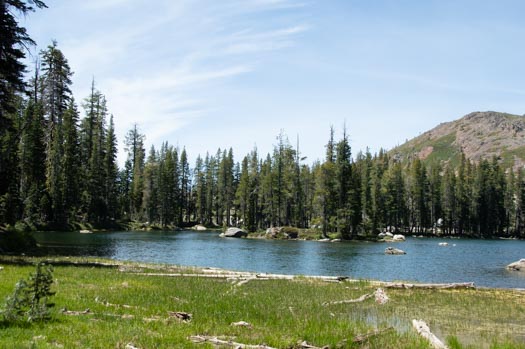










































0 Responses
I’m so happy I found your recent life of flowers seen at Island Lk recently. I am going there, or to hike Sanford Lake next week and will take your wonderful flower list and descriptions with me. Thank you Lynell
Glad I could help! You might also look at the article from a few years ago about a similar area, which has some other pictures of some things you might see, at https://wildflowers.russellramblings.com/2012/07/grouse-ridge-to-glacier-lake/ .
Note that I don’t always get articles like this posted soon after the hike, as it takes me some time to get things identified and written up. I try to be more current when I post things in my wildflower Facebook page at https://www.facebook.com/CaliforniaWildflowerHikes/
If you do get to Sanford Lake, it would be great if you could leave a comment here about what the conditions are and what you see. I’ve actually not hiked to that particular lake, yet.